Verilog: Difference between revisions
| Line 327: | Line 327: | ||
In the example we were shown both moore and mealy state machines for the same requirements<br> | In the example we were shown both moore and mealy state machines for the same requirements<br> | ||
Moore<br> | Moore<br> | ||
[[File:Screenshot from 2024-12-19 18-16-18.png | [[File:Screenshot from 2024-12-19 18-16-18.png| 300px]]<br> | ||
Mealy<br> | Mealy<br> | ||
[[File:Screenshot from 2024-12-19 18-16-55.png | [[File:Screenshot from 2024-12-19 18-16-55.png| 300px]]<br> | ||
<br> | <br> | ||
A chapter that actually made sense. | A chapter that actually made sense. | ||
Revision as of 05:21, 19 December 2024
Introduction
Dipping my toe into this now I own an fpga
Hello World
This is the first program. There are two files to get it to work, a pcf file which defines things you use in the verilog file. Currently my understanding is it maps hardware to names which you can reference in the verilog file. Here is the project. I only use two buttons in the example but there are four shown for the second example
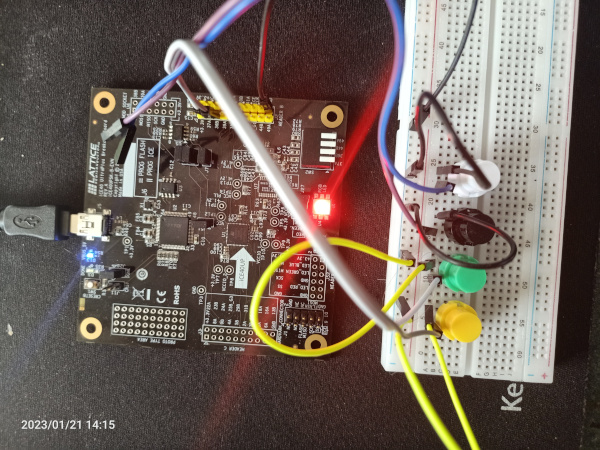 ==Requirements
For the requirements we have only light when both buttons are pressed.
==Requirements
For the requirements we have only light when both buttons are pressed.
Truth Table
We can express this as a circuit diagram and a truth table. We need to understand some boolean algebra to understand the truth table
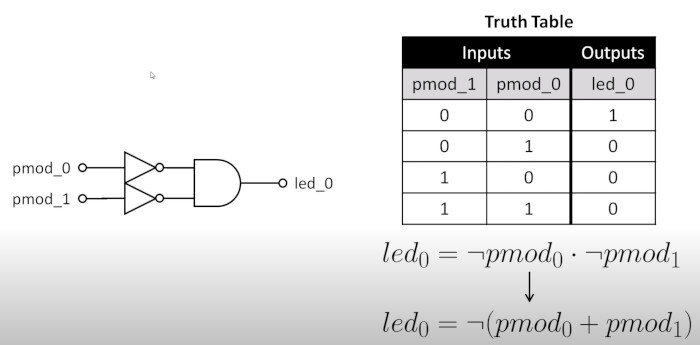
PCF Physical Constraints File (and_gate.pcf)
Could not find a lexer but here we define names to io pins. You lookup the pin in the datasheet, in my case a ice40UP5K-B-EVN and you assign a name.
#LED
set_io led_0 41
#HEADER B I/O
set_io -pullup yes pmod_0 23
set_io -pullup yes pmod_1 25
Verilog File (and_gate.v)
Here is my first program, it defines two input buttons and 1 LED in a module called and_gate. The value of LED is true when pmod_0 and pmod_1 are true.
module and_gate (
// inputs
input pmod_0,
input pmod_1,
// Outputs
output led_0
);
assign led_0 = ~pmod_0 & ~pmod_1;
endmodule
Hello World 2
Well now we have the basics we can add some more verilog stuff. We can reference the inputs and outputs as arrays. We are now going to build a circuit where if we press 1 button, 2 LEDs light up and if we press 2 buttons 2 LED light up. This is shown in the circuit diagram and truth table below
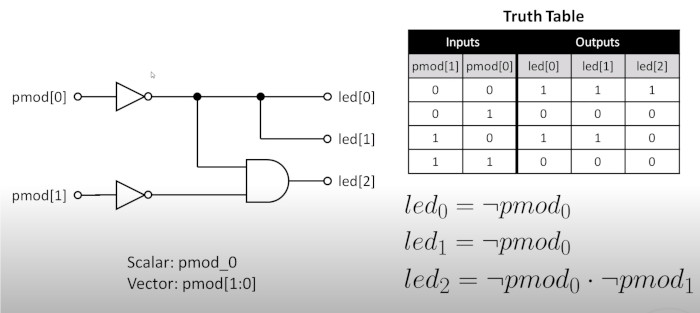
PCF Physical Constraints File (and_gate.pcf)
Not we can put the hardware in array to make the verilog file simpler
#LED
set_io led[0] 23
set_io led[1] 25
set_io led[2] 26
#set_io led[3] 27
#set_io led[4] 32
set_io -pullup yes pmod[0] 36
set_io -pullup yes pmod[1] 42
#set_io -pullup yes pmod_2 12
#set_io -pullup yes pmod_3 14
Verilog File (and_gate.v)
Here is my first program. We basically create a name for the wiring not_pod_0 and assign LED 0,1 to one value and LED 2 to another.
module and_gate (
// inputs
input [1:0] pmod,
// Outputs
output [2:0] led
);
// Wire declaration
wire not_pod_0;
// Continuous Assignment replicate 1 wire to two outputs
assign not_pmod_0 = ~pmod[0];
assign led[1:0] = {2{not_pmod_0}};
// Continuous Assignment: NOT and AND operators
assign led[2] = not_pmod_0 & ~pmod[1];
endmodule
True Adder
Truth Table
Next we make a truth adder using the following
The Cᵢₙ represents the carry value. So you add A + B and the carry to get column S. If there is a carry then Cₒᵤₜ is 1
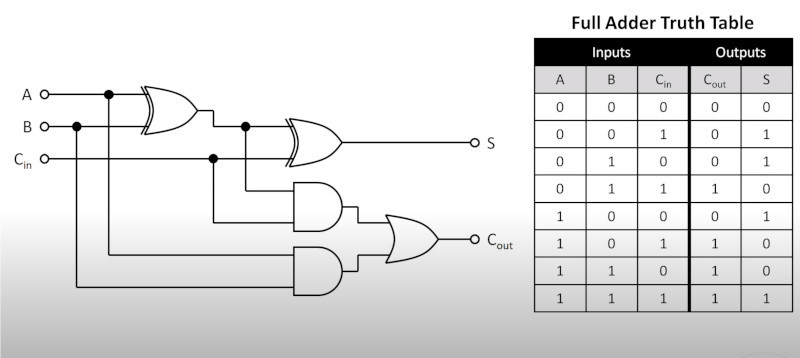
Boolean Algebra representation
Doing my own attempt and it took a couple because it is hard to see the bars and we have
S = (A̅.B̅.C ) + (A̅.B.C̅) + (A.B̅.C̅) + (A.B.C) Cₒᵤₜ = (A̅.B.C ) + (A.B̅.C) + (A.B.C̅) + (A.B.C̅)
Now we need to simplify
Simplification of S
Here is the Simplification of S
Lets take C as common and pair up with 1st and 4th expression and 2 and 3 => C ( A̅.B̅ + A.B ) + C̅ (A̅.B + A.B̅) Found this a bit tricky to wrote up the XOR and NOR above. Basically A̅.B̅ + A.B = A̅ ⊕ B̅ - XOR and A̅.B + A.B̅ = A ⊕ B - NOR => C ( A̅ ⊕ B̅ ) + C̅ ( A ⊕ B) Lets substitute A̅ ⊕ B̅ = x this gives => Cx̅ + C̅x Compliments result in XOR => C ⊕ x Substituting x back in => C ⊕ A ⊕ B
Simplification of Cₒᵤₜ
Here is the Simplification of Cₒᵤₜ
Lets take C as common for 1 and 2 and AB to 3 and 4 => C ( A̅B + AB̅) + AB (C + C̅) Using OR law (Z + Z̅ = 1) we can apply this to the Right hand side
=> C ( A̅B + AB̅) + AB
Using compliments
=> C (A̅ ⊕ B̅) + AB
PCF File
Perhaps the only part I found simple
#LEDS
set_io led[0] 23
set_io led[1] 25
set_io led[2] 26
set_io led[3] 27
set_io led[4] 32
#Push Buttons
set_io -pullup yes pmod[0] 36
set_io -pullup yes pmod[1] 42
set_io -pullup yes pmod[2] 38
set_io -pullup yes pmod[3] 28
Verilog File
Not that hard but do need to understand there result. Here is mine
module full_adder (
// Inputs
input [2:0] pmod,
// Output
output [1:0] led
);
wire A;
wire B;
wire C;
// Set A, B, and C to buttons and off
assign A = ~pmod[0];
assign B = ~pmod[1];
assign C = ~pmod[2];
// Taken from above working
// led[0] C (A̅ ⊕ B̅) + AB
// led[1] C ⊕ A ⊕ B
// Cout
assign led[0] = (C & (!A ^ !B) ) | (A & B);
// S
assign led[1] = C ^ A ^ B;
endmodule
Digi-Keys Solution
Learning Verilog using the digi-key [tutorial]. Mine works but as is my want I need to understand the differences
- leds are reversed
- led[0] and my solution are identical we just need to define a_xor_b
- led[1] I need to understand how ( (a ^ b) & c_in) in their solution = (C & (!A ^ !B) ) in my solution
So here is my explanation for why (A ^ B) = (!A ^ !B)
We know A ^ B = A!B + !AB because of the XOR above If we substitute A and B with there negatives We get A!B + !AB which is A^B
module full_adder (
// Inputs
input [2:0] pmod,
// Output
output [1:0] led
);
// Wire (net) declarations (internal to module)
wire a;
wire b;
wire c_in;
wire a_xor_b;
// A, B, and C_IN are inverted button logic
assign a = ~pmod[0];
assign b = ~pmod[1];
assign c_in = ~pmod[2];
// Create intermediate wire (net)
assign a_xor_b = a ^ b;
// Create output logic
assign led[0] = a_xor_b ^ c_in;
assign led[1] = (a_xor_b & c_in) | (a & b);
endmodule
Always and Registers
The next example is to demonstrate how these work. Hopefully comments in line make it obvious
module button_counter (
// Inputs
input [2:0] pmod,
// Output
output reg [3:0] led
);
wire rst;
wire clk;
assign rst = ~pmod[0];
assign clk = ~pmod[1];
// Like a loop
// while(clk or rst) {
// if(rst){
// led[0-3] = b0
// } else {
// led[ led[current] +1] = b1
// }
// }
always @(posedge clk or posedge rst) begin
if(rst == 1'b1) begin
led <= 4'b0;
end else begin
led <= led + 1'b1;
end
end
endmodule
Clocks
Got this to work and understood it. Cannot seem to replace clock with crystal clearly more to learn.
module button_counter (
// Inputs
input clk,
input rst_btn,
// Output
output reg [3:0] led
);
wire rst;
// Create some registers
reg div_clk;
reg [31:0] count;
// 10110111000110110000000 = 6000000 in Binary
localparam [31:0] max_count = 6000000;
// Reset is the inverse of the reset button
assign rst = ~rst_btn;
// Count up on (divided) clock rising edge or reset on button push
// while (div_clk or reset) {
// if (reset == 1) {
// led[0-3] = 0
// }
// else {
// led[ led[current] +1] = b1
// }
// }
always @ (posedge div_clk or posedge rst) begin
if (rst == 1'b1) begin
led <= 4'b0;
end else begin
led <= led + 1'b1;
end
end
// Count up on (divided) clock rising edge or reset on button push
// while (clk or reset) {
// if (reset == 1) {
// count[0-31] = 0
// }
// else if (count = max_count) {
// count[0-31] = 0
// div_clk = !div_clk;
// }
// else {
// count = count +1
// }
// }
always @ (posedge clk or posedge rst) begin
if (rst == 1'b1) begin
count <= 32'b0;
end else if (count == max_count) begin
count <= 32'b0;
// Revisiting this, it was this line I struggled with but the answer is pretty easy
// One invert the value if the max_count has been achieved. We invert because we don't know if it is one or zero
div_clk <= ~div_clk;
end else begin
count <= count + 1;
end
end
endmodule
Mealy and Moore Finite State Machines (FSM)
Finite State Machines
Thought I knew about these. Turns out I need to match knowledge to theory. Here is how we show finite state machines. Either with a table or a diagram. The circles represent states and the double circles are what is called accepeting states.
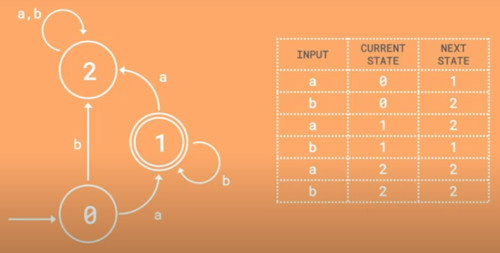
Working through the logic we find it is just fancy language which is good because we can communicate and understand each other.
- Q is a finite set of states.
- ∑ is a finite set of symbols called the alphabet.
- 8δ is the transition function where δ: Q × ∑ → Q
- q0 is the initial state from where any input is processed (q0 ∈ Q).
- F is a set of final state/states of Q (F ⊆ Q).
Looking at the video kinda explained it all. Note there is a arrow usually to show the start state.
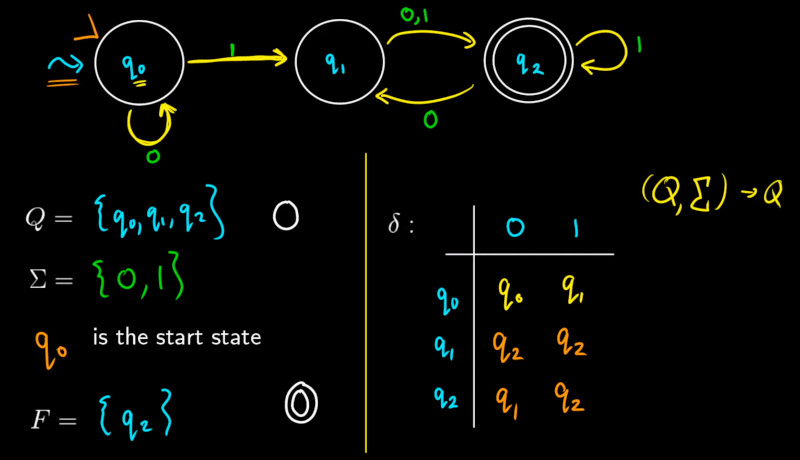
Verilog Example
Moore and Mearly State Machine
In the example we were shown both moore and mealy state machines for the same requirements
Moore
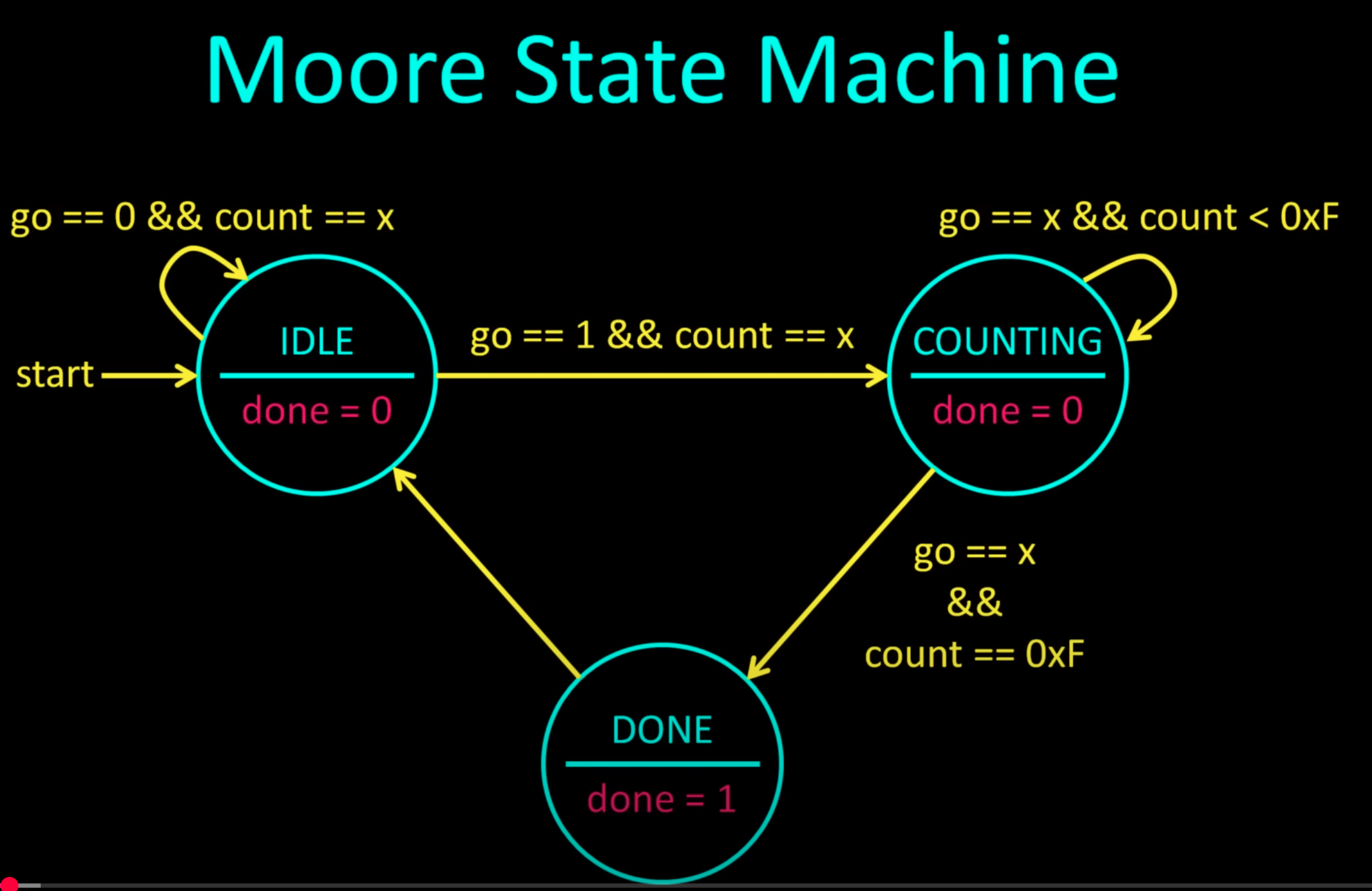
Mealy
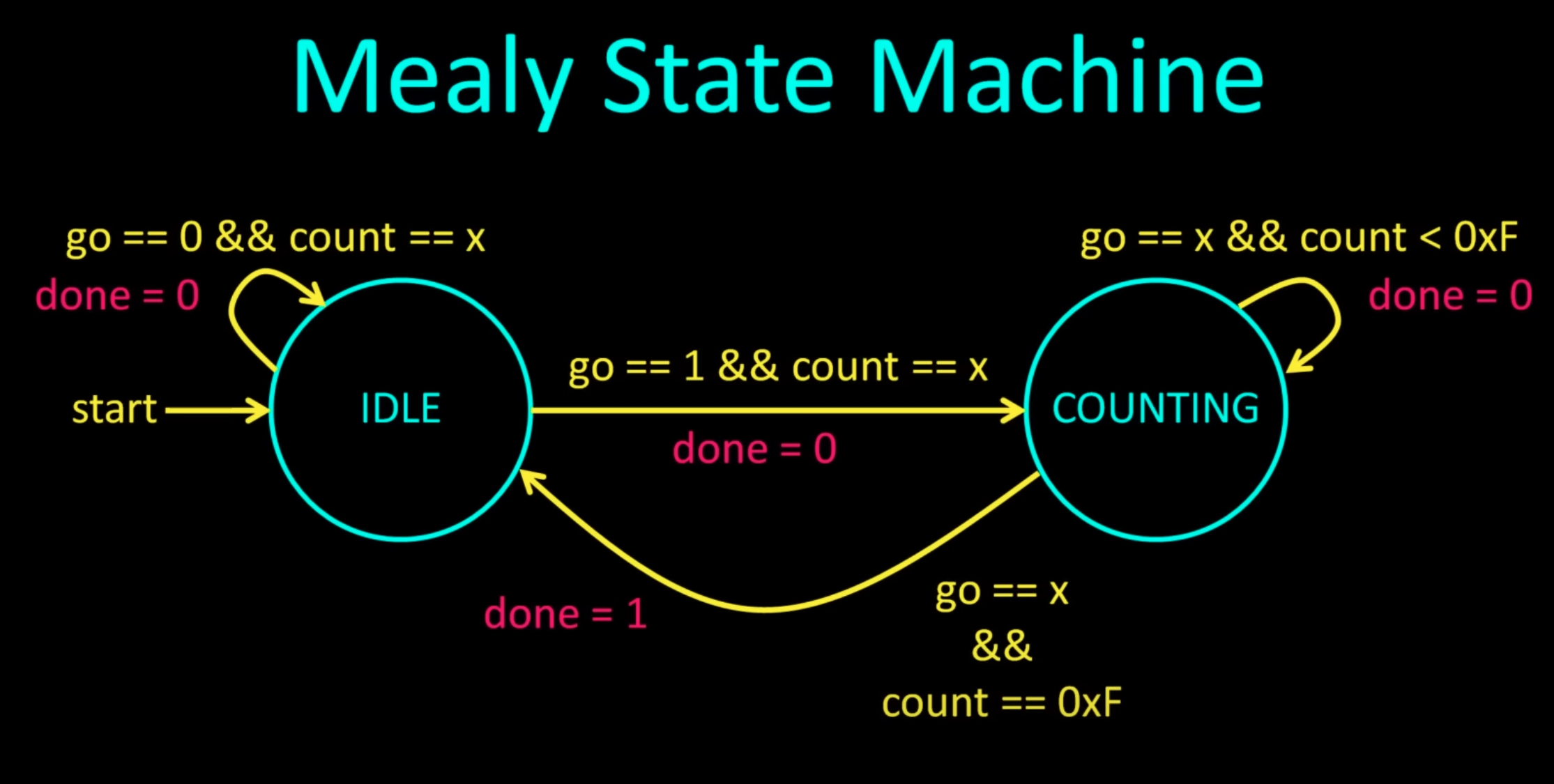
A chapter that actually made sense.
module mealy_fsm (
// Inputs
input clk,
input rst_btn,
input go_btn,
// Outputs
output reg [3:0] led,
output reg done_sig
);
// States
localparam STATE_IDLE = 2'd0;
localparam STATE_COUNTING = 2'd1;
localparam STATE_DONE = 2'd2;
// Not the letter before the value is the type
// b = binary
// d = decimal
// h = hex
// Max counts for clock divider and counter
localparam MAX_CLK_COUNT = 24'd1500000;
localparam MAX_LED_COUNT = 4'hf;
// Internal signals
wire rst;
wire go;
// Internal storage elements
reg div_clk;
reg [1:0] state;
reg [23:0] clk_count;
// Invert active-low buttons
assign rst = ~rst_btn;
assign go = ~go_btn;
// clock divider no change except for values
always @ (posedge clk or posedge rst) begin
if (rst == 1'b1) begin
clk_count <= 24'b0;
end else if (clk_count == MAX_CLK_COUNT) begin
clk_count <= 24'b0;
div_clk <= ~div_clk;
end else begin
clk_count <= clk_count + 1;
end
end
// State transition logic
always @ (posedge div_clk or posedge rst) begin
// On reset, return to idle state and restart counters
if (rst == 1'b1) begin
state <= STATE_IDLE;
// Define the state transitions
end else begin
case (state)
// Wait for go button to be pressed
STATE_IDLE: begin
if (go == 1'b1) begin
state <= STATE_COUNTING;
end
end
// Go from counting to done if counting reaches max
STATE_COUNTING: begin
if (led == MAX_LED_COUNT) begin
state <= STATE_DONE;
end
end
// Default case: return to idle state
default: state <= STATE_IDLE;
endcase
end
end
// Run counter if in wait state
always @ (posedge div_clk or posedge rst) begin
if (rst == 1'b1) begin
led <= 4'd0;
end else begin
if (state == STATE_COUNTING) begin
led <= led + 1;
end else begin
led <= 4'd0;
end
end
end
always @ ( * ) begin
if (state == STATE_DONE) begin
done_sig = 1'b1;
end else begin
done_sig = 1'b0;
end
end
endmodule